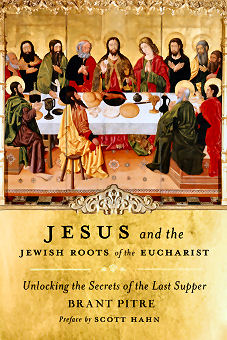
|
Posted May 19, 2011
Book: Jesus and the Jewish Roots of the Eucharist: Unlocking the Secrets to the Last Supper Author: Brant Pitre Doubleday Religion. New York. 2011. Pp. 228 An Excerpt from the Introduction:
Jesus had to have made sense in his own context, and his context is that of Galilee and Judea. Jesus cannot be fully understood unless he is understood through first-century Jewish eyes and heard through first-century Jewish ears. . .To understand Jesus’ impact in his own setting — why some chose to follow him, others to dismiss him, and still others to seek his death — requires an understanding of that setting. Levine’s words are paralleled in a recent book by Pope Benedict XVI, who writes: It must be said that the message of Jesus is completely misunderstood if it is separated from the context of the faith and hope of the Chosen People: like John the Baptist, his direct Precursor, Jesus above all addresses Israel, in order to “gather” it together in the eschatological time that arrived with him. These are strong words. According to Pope Benedict, to the extent that you separate the words of Jesus from the faith and hope of the Jewish people, you risk “completely misunderstanding” him. As we will see in this book, this is precisely what has happened with various interpretations of Jesus’ words at the Last Supper. Jesus’ Jewish context has been repeatedly ignored and as a result, many readers of the Gospels have not understood him. In addition, I also hope to show that by focusing on the Jewish context of Jesus’ teachings, all of his words not only begin to make sense; they come alive in a way that is exciting and powerful. I can testify to this from experience; the more I’ve studied Jesus’ teachings in their Jewish environment, the more he fascinates me, and the more he challenges me to change the way I see who he was, what he was doing, and what it means for my life today. An Excerpt from the Book: The New Passover in Ancient Christianity Jesus’ understanding of the Last Supper as a new Passover is also the explanation for why the earliest Christian writers — both inside and outside the New Testament — would also speak of the Eucharist in terms of the Passover. Historically, this idea was rooted in the Jewish hope for a messianic Passover and in the actions of Jesus himself. However, the early Christians took it and gave it a central place in their explanations of the meaning and mystery of the Eucharist. In the New Testament, there are a couple of key examples of this. In the last book of the Bible — the book of Revelation — John the seer has a vision of Jesus in heaven. What John sees, however, is not a man, but “a Lamb, standing as though slain.” The symbolism of this vision is powerful: the mystery of Jesus’ identity is revealed in the heavenly Passover lamb, who is both cruicified (“slain”) and risen (“standing”). Through the power of the Lamb’s “blood” beleivers are made into “a kingdom and priests to our God,” just as the Israelites were called to be “a kingdom of priests” at the time of the Exodus. This strongly suggests that the heavenly worship surrounding this Lamb — which John describes in great detail — is not just any liturgical celebration, but a heavenly Passover. Equally striking, Saint Paul links the sacrifice of Christ as Passover lamb to the celebration of a new “feast” of unleavened bread among the Christians: Do you not know that a little leaven leavens the whole lump? Cleanse out the old leaven that you may be a new lump, as you really are unleavened. For Christ, our passover lamb, has been sacrificed. Let us, therefore, keep the feast, not with the old leaven, the leaven of malice and evil, but with the unleavened bread of sincerity and truth. Remember that the Jewish Passover could only be celebrated with unleavened bread. In light of this, Paul is drawing out the moral implications of Jesus’ identity asthe new Passover Lamb. If Jesus is the new Passover lamb, then Christians need to prepare to keep the new Passover “feast.” the feast of the Eucharist. They do this not by cleaning out the leaven of the old Passover rite, but by cleansing their hearts of what that leaven symbolized: the uncleanness of sin. Just as the Jews were to remove all leaven and to fast before receiving the Passover, so, too, Paul calls his Christian audience to cleanse their hearts before receiving the Eucharist, lest they “profane the body and blood” of Christ their Passover and thereby “eat and drink judgment” against themselves. Table of Contents: 1. The mystery of the Last Supper 2. What were the Jewish people waiting for? 3. The new Passover 4. The manna of the Messiah 5. The bread of the presence 6. The fourth cup and the death of Jesus 7. The Jewish roots of the Christian faith 8. On the road to Emmaus |
|
